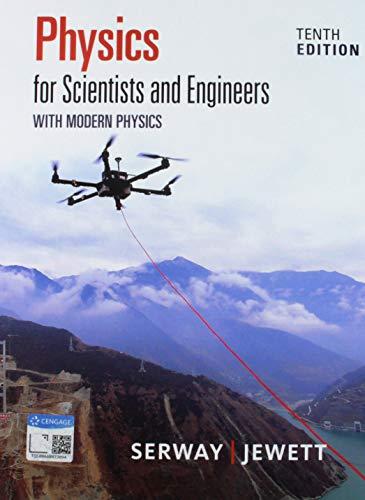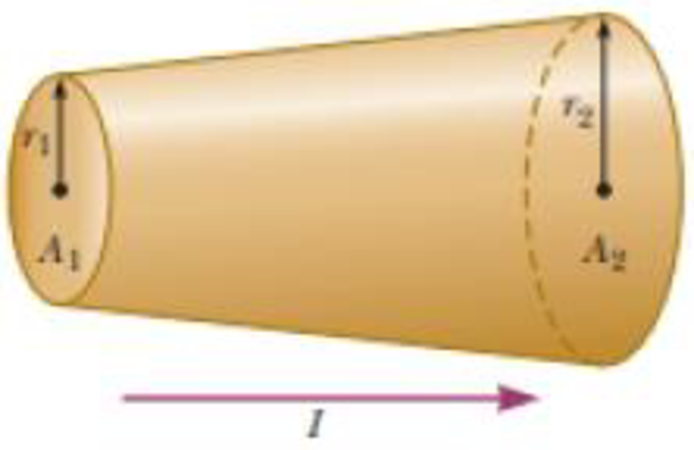
Concept explainers
Figure P26.6 represents a section of a conductor of nonuniform diameter carrying a current of I = 5.00 A. The radius of cross-section A1 is r1 = 0.400 cm. (a) What is the magnitude of the current density across A1? The radius r2 at A2 is larger than the radius r1 at A1. (b) Is the current at A2 larger, smaller, or the same? (c) Is the current density at A2 larger, smaller, or the same? Assume A2 = 4A1. Specify the (d) radius, (e) current, and (f) current density at A2.
Figure P26.6

(a)
The magnitude of the current density across
Answer to Problem 6P
The magnitude of the current density across
Explanation of Solution
Given information: Current carried by a conductor is
Write the expression for the area of cross section of a conductor.
Here,
Substitute
Thus, the area of cross section of a conductor is
Formula to calculate the current density across
Here,
Substitute
Thus, the magnitude of the current density across
Conclusion:
Therefore, the magnitude of the current density across
(b)
The reason that the current at
Answer to Problem 6P
The current at
Explanation of Solution
Given information: Current carried by a conductor is
The current is not depending on cross sectional area. So, the current at
Thus, the density at
Conclusion:
Therefore, the density at
area. So, the current at
(c)
The reason that the current density at
Answer to Problem 6P
The current density at
Explanation of Solution
Given information: Current carried by a conductor is
From equation (2),
Formula to calculate the current density across
Here,
Formula to calculate the current density across
Here,
From above relations, the current density is inversely proportional to area of cross section. From the figure given in the question, it is shown that:
Hence, the current density at
Thus, the current density at
Conclusion:
Therefore, the current density at
(d)
The radius of cross section at
Answer to Problem 6P
The radius of cross section at
Explanation of Solution
Given information: Current carried by a conductor is
It is given that the expression for the crossectional area is:
From equation (1),
Write the expression for the area of cross section of a conductor
Write the expression for the area of cross section of a conductor
Here,
Substitute
Substitute
Thus, the area of cross section of a conductor is
Thus, the radius of cross section at
Conclusion:
Therefore, the radius of cross section at
(e)
The current for cross section at
Answer to Problem 6P
The current for cross section at
Explanation of Solution
Given information: Current carried by a conductor is
The current is not depending on cross sectional area. So, the current at
Thus, the current for cross section at
Conclusion:
Therefore, the current for cross section at
(f)
The magnitude of the current density across
Answer to Problem 6P
The magnitude of the current density across
Explanation of Solution
Given information: Current carried by a conductor is
Write the expression for the area of cross section of a conductor
Here,
Substitute
Thus, the area of cross section of a conductor is
Formula to calculate the current density across
Substitute
Thus, the magnitude of the current density across
Conclusion:
Therefore, the magnitude of the current density across
Want to see more full solutions like this?
Chapter 26 Solutions
Bundle: Physics For Scientists And Engineers With Modern Physics, 10th + Webassign Printed Access Card For Serway/jewett's Physics For Scientists And Engineers, 10th, Multi-term
Additional Science Textbook Solutions
Anatomy & Physiology (6th Edition)
Fundamentals Of Thermodynamics
Organic Chemistry
Introductory Chemistry (6th Edition)
Chemistry: Atoms First
Biology: Life on Earth (11th Edition)
- Two objects get pushed by the same magnitude of force. One object is 10x more massive. How does the rate of change of momentum for the more massive object compare with the less massive one? Please be able to explain why in terms of a quantitative statement found in the chapter.arrow_forwardA box is dropped on a level conveyor belt that is moving at 4.5 m/s in the +x direction in a shipping facility. The box/belt friction coefficient is 0.15. For what duration will the box slide on the belt? In which direction does the friction force act on the box? How far will the box have moved horizontally by the time it stops sliding along the belt?arrow_forwardNo chatgpt pls will upvotearrow_forward
- No chatgpt pls will upvotearrow_forwardA toy car speeds up at 1.0 m/s2 while rolling down a ramp, and slows down at a rate of 2.0 m/s2 while rolling up the same ramp. What is the slope of the ramp in degrees? Grade in %? The friction coefficient?arrow_forwardPlz solution should be complete No chatgpt pls will upvote .arrow_forward
- A box with friction coefficient of 0.2 rests on a 12 foot long plank of wood. How high (in feet) must one side of the plank be lifted in order for the box to begin to slide?arrow_forwardWhat is a good general rule to follow in order to find the best choice of coordinate system to solve a dynamics problem?arrow_forwardWhat is the meaning of a first order approximation?arrow_forward
 Principles of Physics: A Calculus-Based TextPhysicsISBN:9781133104261Author:Raymond A. Serway, John W. JewettPublisher:Cengage Learning
Principles of Physics: A Calculus-Based TextPhysicsISBN:9781133104261Author:Raymond A. Serway, John W. JewettPublisher:Cengage Learning
 Physics for Scientists and Engineers with Modern ...PhysicsISBN:9781337553292Author:Raymond A. Serway, John W. JewettPublisher:Cengage Learning
Physics for Scientists and Engineers with Modern ...PhysicsISBN:9781337553292Author:Raymond A. Serway, John W. JewettPublisher:Cengage Learning Physics for Scientists and Engineers: Foundations...PhysicsISBN:9781133939146Author:Katz, Debora M.Publisher:Cengage Learning
Physics for Scientists and Engineers: Foundations...PhysicsISBN:9781133939146Author:Katz, Debora M.Publisher:Cengage Learning Physics for Scientists and EngineersPhysicsISBN:9781337553278Author:Raymond A. Serway, John W. JewettPublisher:Cengage Learning
Physics for Scientists and EngineersPhysicsISBN:9781337553278Author:Raymond A. Serway, John W. JewettPublisher:Cengage Learning College PhysicsPhysicsISBN:9781938168000Author:Paul Peter Urone, Roger HinrichsPublisher:OpenStax College
College PhysicsPhysicsISBN:9781938168000Author:Paul Peter Urone, Roger HinrichsPublisher:OpenStax College





